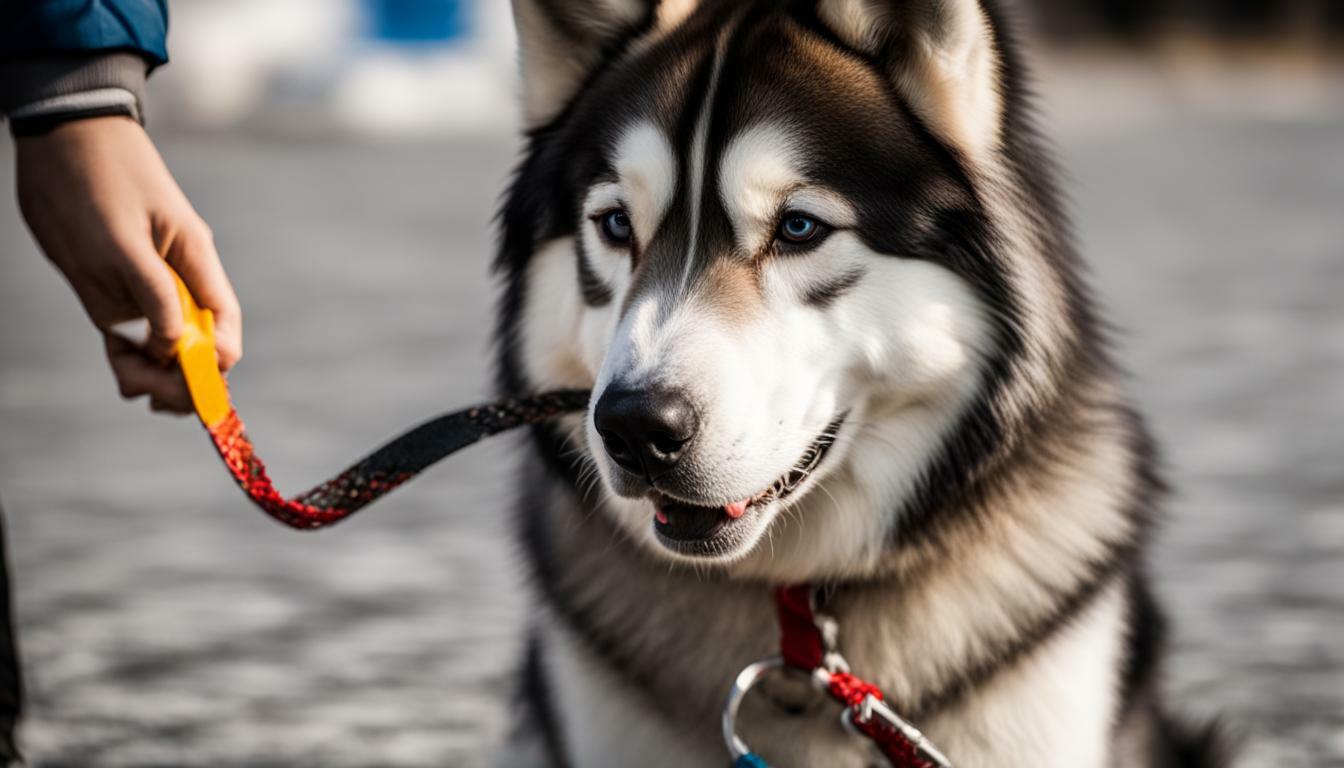Training an Alaskan Malamute requires a solid understanding of training principles and effective techniques to unlock success in obedience and behavior. Consistency, positive reinforcement, and early training play crucial roles in shaping a well-behaved and happy Malamute. Short and focused training sessions, using clear and simple commands, ensure optimal learning and engagement. It is essential to approach training with patience and realistic expectations, avoiding punishment-based methods that can harm their sensitive nature.
Within this comprehensive guide, we will explore the key training principles for Alaskan Malamutes, including the benefits of positive reinforcement and the importance of consistency. We will also delve into the significance of early training for Alaskan Malamute puppies, socialization techniques, and redirecting unwanted behaviors. Additionally, we will discuss the advantages of online training courses and the crucial role of nutrition, exercise, grooming, and regular vet care in maintaining a well-behaved and healthy Alaskan Malamute.
Join us on this journey to unlock success in training your Alaskan Malamute. With the right knowledge, techniques, and resources, you can create a strong bond with your furry companion and enjoy a lifetime of obedience, companionship, and happiness together.
Key Training Principles for Alaskan Malamutes
Positive reinforcement and consistency are crucial when training an Alaskan Malamute, ensuring a harmonious relationship and successful training outcomes. By using positive reinforcement techniques, such as rewards, praise, and treats, you can motivate your Malamute and reinforce desired behaviors. Remember to be consistent with your commands and rewards, as this will help your dog understand what is expected of them.
In addition to positive reinforcement, it is important to establish clear and simple commands for your Alaskan Malamute. Use short and concise phrases that are easy for them to understand and remember. This will aid in their comprehension and make training sessions more effective.
“Consistency is key when training an Alaskan Malamute. By setting clear expectations and consistently reinforcing desired behaviors, you can help your dog understand what is expected of them.”
Another important aspect of training an Alaskan Malamute is to keep training sessions short and focused. Malamutes have a tendency to become bored easily, so shorter sessions of around 10-15 minutes are recommended. This will help maintain their interest and prevent them from losing focus.
Remember, training is a process that requires patience and realistic expectations. Each dog learns at their own pace, so be patient and provide consistent guidance. Avoid punishment-based training methods, as they can be detrimental to the training process and may cause fear or aggression in your Malamute. Instead, focus on positive reinforcement techniques that reward good behavior and foster a strong bond between you and your furry friend.
Table: Effective Training Techniques for Alaskan Malamutes
| Technique | Description |
|---|---|
| Positive Reinforcement | Rewarding desired behaviors with treats, praise, or playtime. |
| Consistency | Setting clear expectations and consistently reinforcing desired behaviors. |
| Clear Commands | Using short and concise phrases that are easy for your Malamute to understand. |
| Short Training Sessions | Keeping sessions around 10-15 minutes to maintain your dog’s focus and prevent boredom. |
| Avoid Punishment | Avoiding punishment-based training methods that can be harmful and counterproductive. |
By following these key training principles and techniques, you can build a strong foundation for training your Alaskan Malamute and unlock their full potential. Remember to be patient, consistent, and positive throughout the process, and you’ll be well on your way to a well-trained and happy Malamute.
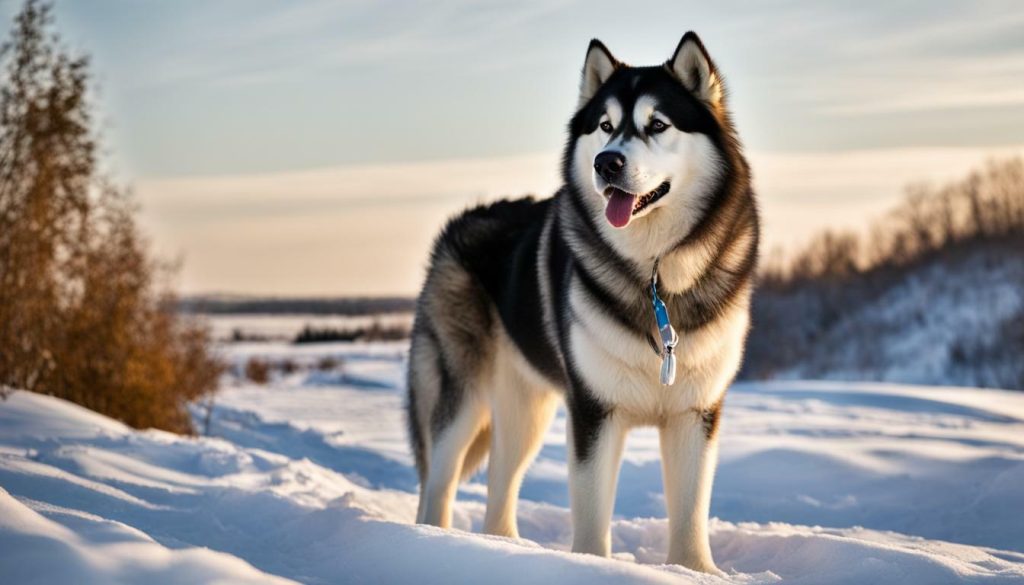
Early training is vital for Alaskan Malamute puppies to develop good behavior and obedience, setting the stage for long-term success. By starting training at a young age, you can establish a strong foundation and teach them basic commands that will shape their behavior as they grow. Consistency is key during this early stage, as puppies are like sponges, eager to learn and please.
When training your Alaskan Malamute puppy, it’s important to keep the sessions short and focused. Their attention span is still developing, so aim for brief, frequent training sessions rather than one long session. Use clear and simple commands that they can easily understand. Positive reinforcement, such as treats, praise, and play, will motivate them to learn and respond to your commands.
Socialization is another crucial aspect of training a Malamute puppy. Expose them to different environments, people, and other animals to help them become well-rounded and confident. Socialization not only helps prevent behavioral issues but also promotes positive interactions with others. Redirecting unwanted behaviors, such as chewing or nipping, is important to teach them appropriate ways to express themselves.
Table: Recommended Basic Commands for Alaskan Malamute Puppies
| Command | Description |
|---|---|
| Sit | Teaches your puppy to sit on command, promoting calm behavior and control. |
| Stay | Teaches your puppy to remain in one place until released, promoting patience and discipline. |
| Come | Teaches your puppy to come to you when called, ensuring their safety and reinforcing bonding. |
| Leave it | Teaches your puppy to leave objects or food alone, preventing destructive behavior and protecting their health. |
| Drop it | Teaches your puppy to release objects from their mouth, promoting safety and preventing resource guarding. |
Remember, training your Alaskan Malamute puppy is a journey that requires patience and consistency. Celebrate their successes and be gentle with corrections. By investing time and effort into their early training, you are setting them up for a lifetime of good behavior and a strong bond with you as their owner.
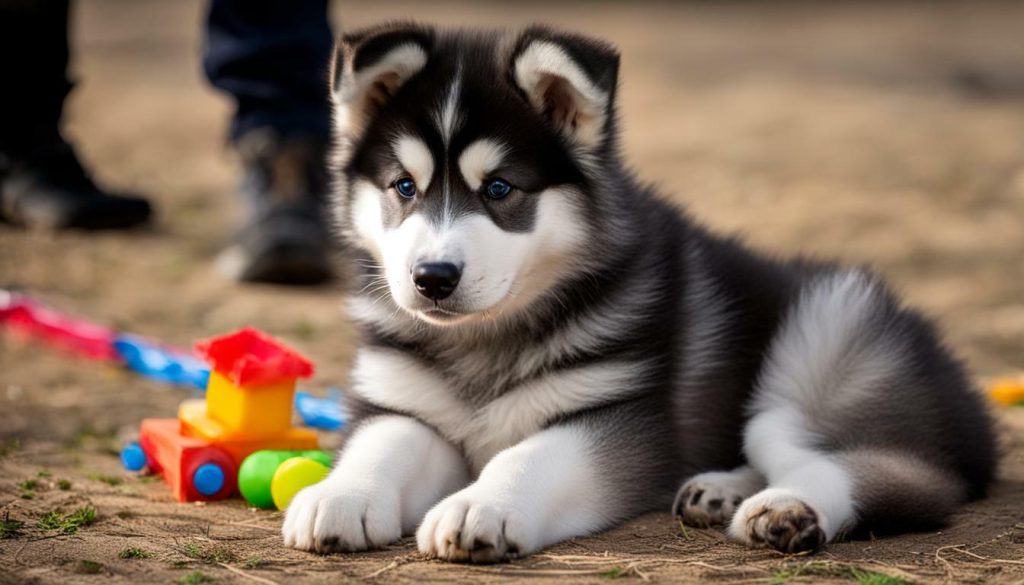
“The key to successful training lies in the early stages. Start training your Alaskan Malamute puppy as soon as you bring them home, and you’ll be amazed by the progress they can make!”
The Importance of Patience and Realistic Expectations
Patience and realistic expectations are essential when training an Alaskan Malamute, ensuring a productive and rewarding training experience. It is important to understand that training takes time and consistency, and rushing the process can lead to frustration for both you and your furry companion. Remember that each dog is unique, and progress may vary from one Malamute to another.
To set realistic expectations, focus on small achievements and celebrate them along the way. Alaskan Malamutes are known for their independent nature, so it is important to approach training with a calm and patient demeanor. Avoid getting discouraged by setbacks and setbacks. Instead, stay positive and maintain a consistent training routine.
When training an Alaskan Malamute, it is crucial to avoid punishment-based methods. These methods can be counterproductive and may cause fear or aggression in your dog. Instead, opt for positive reinforcement techniques, such as rewards and praise, to motivate your Malamute and encourage desired behaviors. Consistency and clear communication are key, so use simple and consistent commands to help your dog understand what is expected.
By setting realistic expectations, practicing patience, and using positive reinforcement techniques, you will create a strong bond with your Alaskan Malamute and unlock their full potential.
Achieve Success through Consistency and Positive Reinforcement
| Training Principle | Description |
|---|---|
| Consistency | Stick to a regular training schedule and use consistent commands to reinforce desired behaviors. |
| Positive Reinforcement | Reward your Alaskan Malamute with treats, praise, or playtime to reinforce good behavior. |
| Clear Communication | Use simple and concise commands to help your dog understand what is expected. |
| Patience | Remember that training takes time and patience. Stay calm and positive throughout the process. |
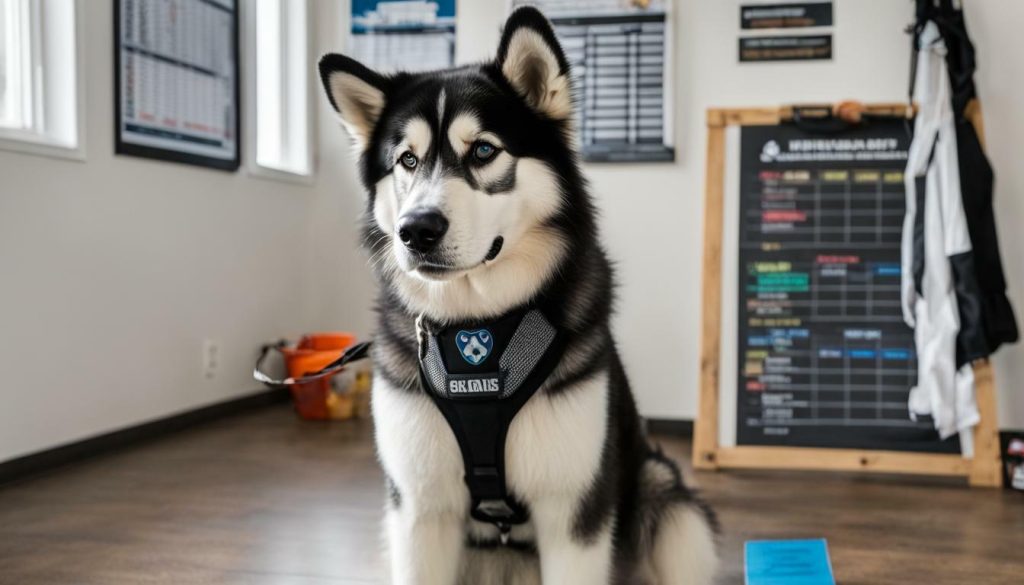
“Training a Malamute is a journey that requires patience and understanding. Consistency, positive reinforcement, and clear communication are the keys to success.”
– Dog Training Expert
Avoiding Punishment-Based Training
Punishment-based training methods should be avoided when working with Alaskan Malamutes, as they can have adverse effects on their temperament and overall training progress. These dogs are known for their sensitive nature and respond best to positive reinforcement techniques. Instead of using punishment as a means of correction, it is recommended to focus on rewards and praise to motivate and encourage desired behaviors.
As an owner, you should establish a clear set of rules and consistently reinforce them through positive reinforcement. Use treats, toys, or verbal praise to reward your Malamute when they exhibit good behavior, such as following commands or showing obedience. By using positive reinforcement, you create a positive association and strengthen the bond between you and your dog.
It is important to remember that training takes time and patience. Avoid getting frustrated or resorting to punishment when your dog doesn’t immediately respond to a command. Instead, break down the training into smaller, manageable steps and gradually increase difficulty. This allows your Alaskan Malamute to understand and learn at their own pace, leading to better results in the long run.
Quote: “Positive reinforcement is not only more effective in teaching your Alaskan Malamute, but it also fosters trust, builds confidence, and strengthens the bond between you and your furry companion.” – Dog Training Expert
| Benefits of Avoiding Punishment-Based Training |
|---|
| Promotes a positive and trusting relationship between you and your Alaskan Malamute |
| Encourages your dog to actively participate and enjoy the training process |
| Reduces the risk of anxiety or fear-based behaviors in your Malamute |
| Produces long-lasting and reliable obedience |
By adopting effective Alaskan Malamute training techniques that focus on positive reinforcement, you can create a harmonious environment that promotes learning, growth, and a well-behaved companion. Remember, your dog’s happiness and willingness to learn are the ultimate goals, and avoiding punishment-based methods is a crucial step in achieving success.
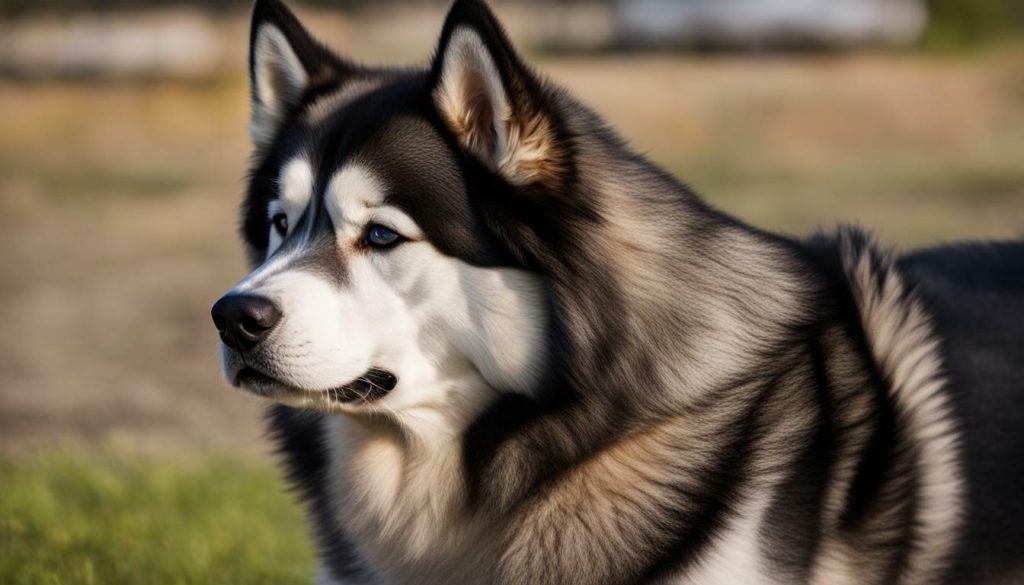
Socialization and redirection techniques play a crucial role in shaping the behavior of an Alaskan Malamute, promoting a well-rounded and obedient companion. By exposing your Malamute to various people, animals, and environments from an early age, you can help them become more confident, adaptable, and friendly. Socialization not only enhances their social skills but also reduces the likelihood of fear-based aggression or anxiety-driven behaviors later in life.
One effective way to socialize your Alaskan Malamute is through controlled and positive interactions. Introduce them to new experiences gradually, rewarding calm and friendly behavior. Use treats or praise to reinforce their positive interactions with people and other animals. It’s important to remember that every dog is unique, so take their comfort level into consideration, gradually increasing the level of exposure as they become more confident.
Alongside socialization, redirecting unwanted behaviors is an essential aspect of Alaskan Malamute training. Malamutes are known for their high energy levels and independent nature, which can lead to behaviors such as excessive barking, digging, or chewing. To address these behaviors, provide them with appropriate outlets for their energy, such as regular exercise and stimulating toys. Rewarding desirable behavior and redirecting their attention to a more appropriate activity can effectively discourage unwanted behaviors over time.
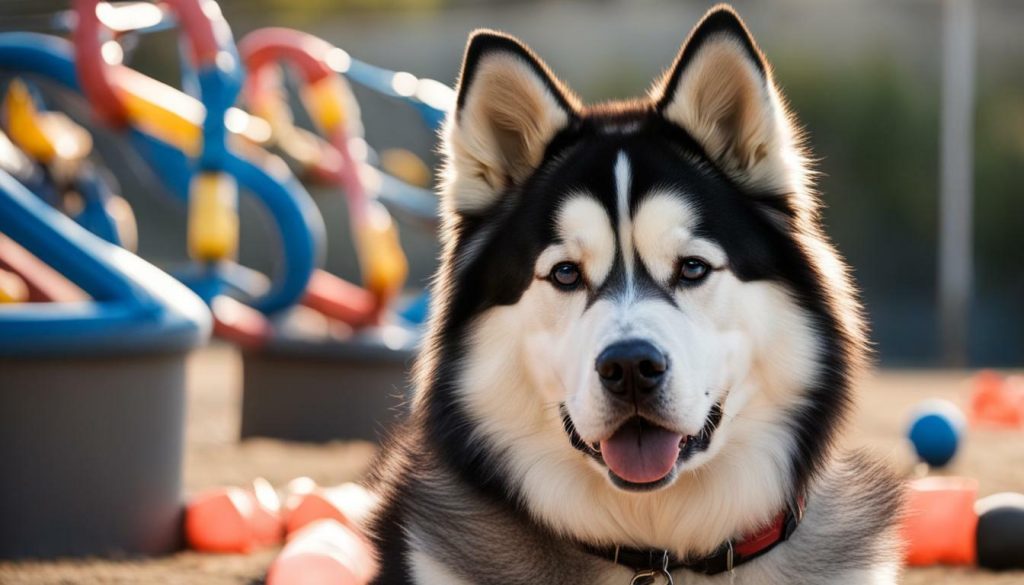
Effective Training Tips for Socialization and Redirecting Unwanted Behaviors
| Tip | Description |
|---|---|
| Gradual Exposure | Introduce your Malamute to new experiences and environments gradually, allowing them to adjust at their own pace. |
| Positive Reinforcement | Reward your Malamute with treats, praise, or playtime when they exhibit desired behavior during socialization or redirection. |
| Consistency | Consistently reinforce desired behavior and redirect unwanted behavior to establish clear boundaries and expectations. |
| Exercise and Stimulation | Provide your Malamute with regular exercise, both mental and physical, to channel their energy into positive outlets. |
Remember, every Alaskan Malamute is unique, so it’s important to be patient and adaptable in your training approach. With consistency, positive reinforcement, and a focus on socialization and redirection, you can help shape your Alaskan Malamute into a well-behaved and happy companion.
The Benefits of Online Training Courses
Online training courses provide a convenient and effective way to enhance your Alaskan Malamute’s training, offering expert guidance and support from the comfort of your own home. These courses are designed to cater to the specific needs of Alaskan Malamutes, providing you with valuable insights, strategies, and techniques to train your furry companion effectively.
One of the key benefits of online training courses is their accessibility. You can access the courses at any time that suits your schedule, allowing you to learn and train at your own pace. This flexibility is especially helpful for busy individuals who may not have the time to attend in-person training sessions.
Another advantage of online training courses is the expert guidance you receive. These courses are developed and taught by experienced dog trainers who specialize in Alaskan Malamutes. They understand the unique characteristics and challenges of this breed and can provide tailored advice to address specific behavioral issues or training goals.
Furthermore, online training courses often provide a supportive community where you can connect with fellow Alaskan Malamute owners. This community platform allows you to share your experiences, ask questions, and seek advice from others who are on a similar training journey. It creates a supportive network that can further enhance your training experience.
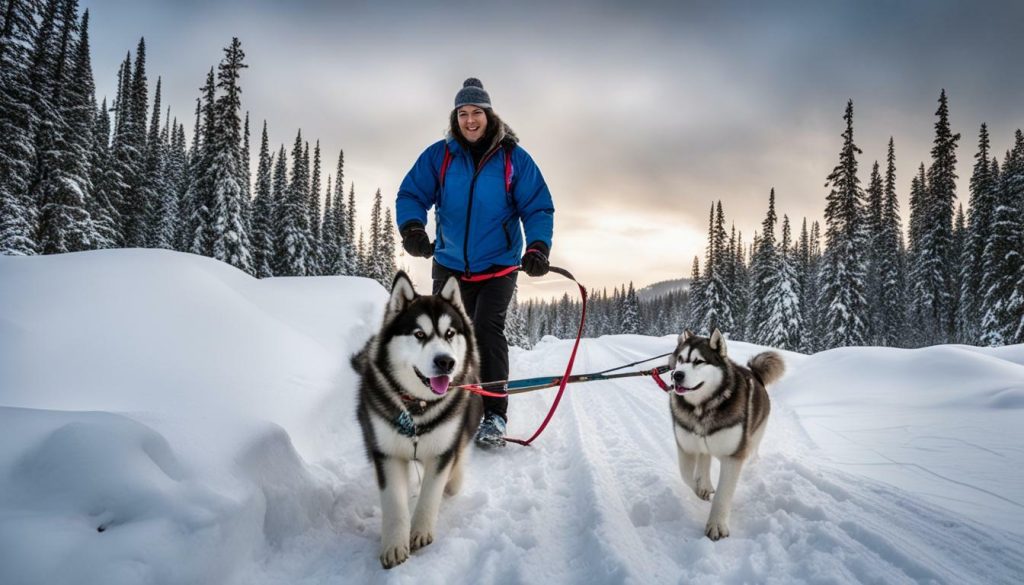
| Benefits of Online Training Courses |
|---|
| Convenient and flexible access |
| Expert guidance from experienced trainers |
| Supportive community of Alaskan Malamute owners |
The Role of Nutrition and Exercise in Training
Providing proper nutrition and regular exercise is essential for training an Alaskan Malamute, ensuring they are in prime condition for learning and behaving well. A well-balanced diet that meets the nutritional needs of your furry friend is crucial. High-quality dog food that contains a good balance of protein, carbohydrates, and healthy fats will provide the energy and nutrients necessary for their active lifestyle.
In addition to nutrition, regular exercise is vital for the overall well-being and training success of your Alaskan Malamute. These dogs have a lot of energy to burn, and regular physical activity helps to keep them mentally stimulated and physically fit. Daily walks, playtime, and interactive toys are excellent ways to engage their active minds and bodies. Remember that a tired dog is often a well-behaved dog.
One effective way to incorporate exercise into your Alaskan Malamute’s routine is by engaging them in activities that match their natural instincts, such as hiking, running, or participating in dog sports like agility or obedience trials. These activities provide mental and physical stimulation while reinforcing positive behaviors and strengthening the bond between you and your furry companion.
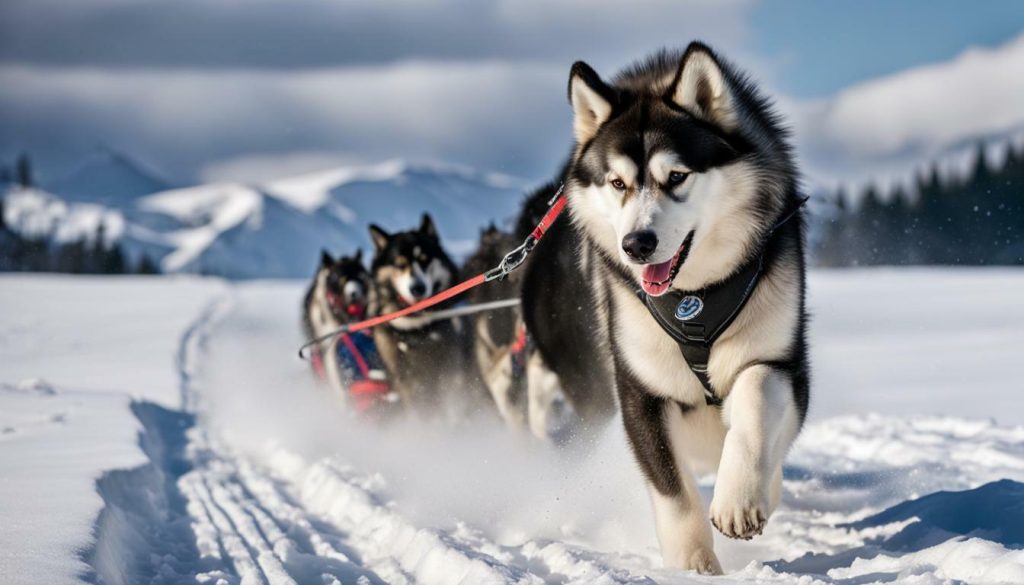
In summary, providing proper nutrition and regular exercise are crucial components of training an Alaskan Malamute. A well-balanced diet and regular physical activity not only contribute to their overall health but also set the foundation for successful training. Remember, a healthy and happy Alaskan Malamute is more receptive to learning and will be more likely to exhibit good behavior.
Grooming and Regular Vet Care for a Well-Behaved Malamute
Grooming and regular vet care are key components in shaping a well-behaved Alaskan Malamute, ensuring they are healthy and comfortable during their training journey. The thick, double coat of an Alaskan Malamute requires regular brushing to prevent matting and reduce shedding. A grooming routine should include brushing their coat at least twice a week, trimming their nails as needed, cleaning their ears, and brushing their teeth regularly. Regular grooming not only keeps your Malamute looking their best but also promotes bonding and establishes a sense of trust between you and your furry companion.
When it comes to regular vet care, scheduling routine check-ups and vaccinations is crucial for the overall health and well-being of your Alaskan Malamute. Your vet will be able to monitor your dog’s growth, assess their weight, and address any underlying health issues that may affect their training progress. Regular check-ups also allow your vet to provide guidance on preventative care, such as flea and tick control and heartworm prevention. Additionally, they can offer advice on nutrition tailored to your Malamute’s specific needs, ensuring they receive a balanced diet to support their energy levels and optimal performance during training.
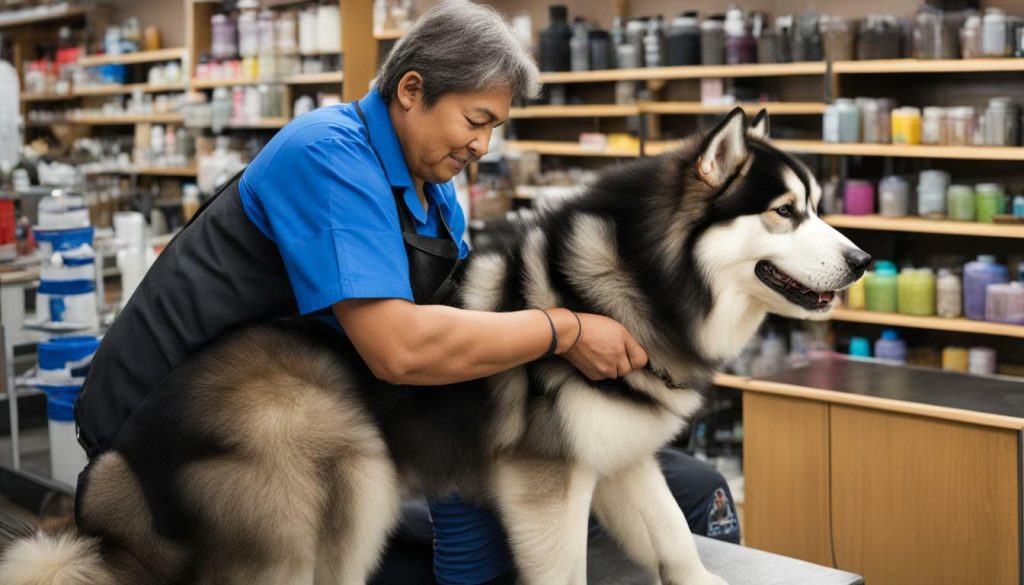
“Grooming not only keeps your Alaskan Malamute looking their best but also promotes bonding and establishes a sense of trust between you and your furry companion.”
By prioritizing grooming and regular vet care, you are setting the foundation for a well-behaved and healthy Alaskan Malamute. These practices not only contribute to their physical well-being but also play a significant role in their mental and emotional state. A happy and comfortable dog is more receptive to training, making the entire process smoother and more enjoyable for both you and your furry friend.
Troubleshooting Common Training Challenges
Training an Alaskan Malamute comes with its fair share of challenges, but with the right techniques and troubleshooting strategies, you can overcome any hurdles you may face. It’s important to remember that every dog is unique, and what works for one Malamute might not work for another. Understanding your dog’s behavior and adapting your training approach accordingly is key to success.
One common challenge is leash pulling during walks. Alaskan Malamutes are strong and energetic, and if not properly trained, they may pull on the leash, making walks frustrating and potentially dangerous. To address this issue, consider using a no-pull harness or a head collar, which provide more control and discourage pulling. Additionally, practice loose leash walking by rewarding your Malamute for walking calmly by your side. With consistency and positive reinforcement, you can teach your dog to walk politely on a leash.
Another challenge is excessive barking. Alaskan Malamutes are known for their vocal nature, but excessive barking can be disruptive and annoying. To address this behavior, first try to identify the cause of the barking. Is your dog bored, anxious, or trying to alert you to something? Once you understand the trigger, you can redirect their attention to more appropriate behaviors. Provide mental and physical stimulation through puzzle toys, interactive play sessions, and regular exercise. Reward your Malamute for calm and quiet behavior, and consider seeking professional help if the barking persists.
Separation anxiety is another common challenge faced by Alaskan Malamute owners. These dogs are known for their strong bond with their owners and can experience anxiety when left alone. To help alleviate separation anxiety, gradually desensitize your dog to being alone by starting with short periods of time and gradually increasing them. Provide comfort and establish a routine to help your Malamute feel secure. You can also use interactive toys or treat-dispensing puzzles to keep them occupied while you’re away. In severe cases, consult with a professional trainer or behaviorist for guidance.
Common Training Challenges:
| Challenge | Troubleshooting Strategies |
|---|---|
| Leash pulling | – Use a no-pull harness or head collar – Practice loose leash walking with rewards – Seek professional guidance if needed |
| Excessive barking | – Identify the trigger – Provide mental and physical stimulation – Reward calm behavior – Consider professional help if necessary |
| Separation anxiety | – Gradually desensitize to being alone – Establish a comforting routine – Provide interactive toys or puzzles – Consult with a professional if severe |
Remember, consistency, patience, and positive reinforcement are essential when addressing these challenges. Each dog is unique, so be prepared to adjust your training approach to suit your Malamute’s individual needs. With dedication and perseverance, you can overcome these common training hurdles and enjoy a well-behaved and happy Alaskan Malamute.
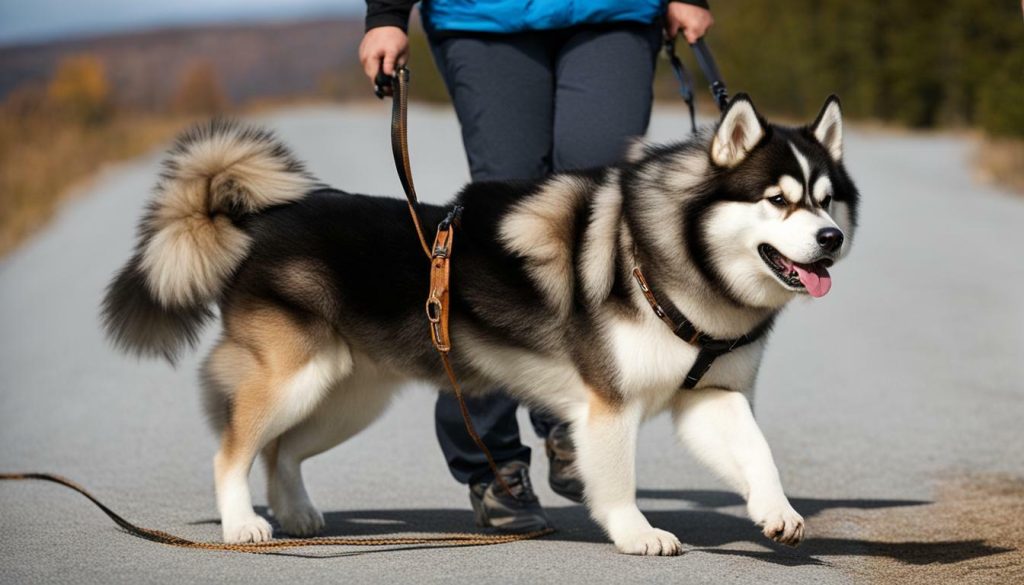
Conclusion: A Well-Trained Alaskan Malamute
Training an Alaskan Malamute is a rewarding journey that results in a well-behaved and obedient companion, creating a harmonious bond between you and your furry friend. By understanding key training principles and avoiding common mistakes, you can unlock success in your training efforts. Consistency, positive reinforcement, and early training are crucial for shaping your Malamute’s behavior.
When training your Alaskan Malamute, keep your sessions short and focused, using clear and simple commands. Patience and having realistic expectations are essential, as rushing the process can lead to frustration. It’s important to remember that punishment-based training methods are counterproductive and can harm your Malamute’s sensitive nature. Instead, focus on positive reinforcement techniques that reward good behavior.
Don’t overlook the importance of socialization and redirecting unwanted behaviors. Properly socializing your Alaskan Malamute helps them develop good manners and adapt well to new environments. Additionally, online training courses can provide valuable guidance and expert advice to enhance your training efforts.
Remember that a well-behaved Alaskan Malamute is also influenced by their overall well-being. Providing proper nutrition and regular exercise is crucial for their physical and mental health, which in turn affects their behavior and trainability. Grooming routines and regular vet care also contribute to a well-behaved and healthy companion.
As you embark on this training journey with your Alaskan Malamute, embrace the rewards that come with a well-trained and obedient companion. The bond you build through training will create a lifetime of joy and companionship for both you and your furry friend.
FAQ
Q: What are the key training principles for Alaskan Malamutes?
A: The key training principles for Alaskan Malamutes include positive reinforcement, consistency, clear commands, and short training sessions.
Q: When should I start training my Alaskan Malamute puppy?
A: It is important to start training your Alaskan Malamute puppy at a young age to establish a foundation for future training and prevent behavioral issues.
Q: Why is patience and having realistic expectations important in training?
A: Patience and having realistic expectations are important because training takes time and consistency. It is essential to remain calm and patient while understanding that progress may be gradual.
Q: Should I use punishment-based training methods with my Alaskan Malamute?
A: No, punishment-based training methods should be avoided as they can have a negative impact on the sensitive nature of Alaskan Malamutes. Positive reinforcement techniques are more effective and yield better results.
Q: How can I socialize my Alaskan Malamute and redirect unwanted behaviors?
A: Socializing your Alaskan Malamute and redirecting unwanted behaviors can be achieved through exposure to different environments, people, and animals. Additionally, positive reinforcement can be used to redirect unwanted behaviors towards more acceptable ones.
Q: Are online training courses beneficial for training an Alaskan Malamute?
A: Yes, online training courses can be beneficial for training an Alaskan Malamute. They provide convenient access to expert guidance and resources that can enhance your training efforts.
Q: How does nutrition and exercise contribute to training an Alaskan Malamute?
A: Nutrition and exercise play a crucial role in maintaining the physical and mental well-being of an Alaskan Malamute, which in turn contributes to better behavior and trainability. A balanced diet and regular exercise are essential.
Q: Why is grooming and regular vet care important for a well-behaved Alaskan Malamute?
A: Grooming routines and regular vet care are important for maintaining a well-behaved Alaskan Malamute. Grooming helps keep their coat clean and healthy, while regular vet care ensures any underlying health issues are addressed, which can affect behavior and training.
Q: How can I troubleshoot common training challenges with my Alaskan Malamute?
A: Common training challenges with an Alaskan Malamute can be addressed through troubleshooting techniques such as revisiting training methods, seeking professional guidance, and adjusting training routines to better suit the individual needs of your dog.
